There are several factors that can adversely affect the range of the Tramper These can be divided into two categories:
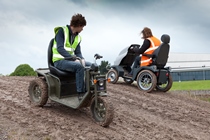
1. Use of power
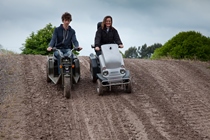
2. Amount of power available from batteries

Use of power: factors that affect the use of power are: gradient, load, type of surface, tyre pressures etc anything that causes the motor to work harder. Typically a Tramper with a warm axle ( it takes about 20 mins to fully warm an axle) on a flat ideal surface will draw around 15-16 amps. Gradients will have more effect than anything else and this will be coupled to the weight of the user. When climbing a slope the motor still has to propel the machine as if it was on the flat, plus it has to lift the weight of the machine at the same time.
For example ( This is not a physics course and for simplicity generalisations are being made.)
On a 1 in 5 slope: for every 1 unit moved horizontally forwards it will also move 0.2 units vertically. Assuming an average user weight of 95kg + 150Kg Tramper total mass will be 245Kg. So if the Tramper is climbing the slope at 3.576M/S (8MPH) it will be lifting 245Kg at 3.576/5m/s. The power to achieve this will be 245*9.81 * .7152 = 1718 Watts. At 100% efficiency 1.718Kw is 71.6Amps at 24 volts a more realistic value, taking into effect that the motor is at best only 80% efficient would be, 71.6*1.2= 85.9A
So to climb the 1in 5 slope it will require 16 amps + 85.9 amps= 101.9amps! This will shorten the range dramatically
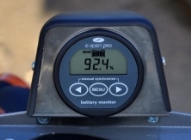
Surface: as previously stated a Tramper on an ideal surface at 8mph uses approximately 16amps. On soft grassland the range could easily drop to 10 miles, this is because it can take up to 48 amps a 300% increase, to propel the Tramper along.
User weight and tyre pressure: the user weight has more effect when climbing slopes.
Tyre pressure: low tyre pressures will increase the rolling resistance and thus reduce the range. However there is an exception, when operating in very soft conditions where flotation is important such as soft sand lowering the rear tyre pressures may reduce the power needed.
Batteries: assuming batteries are fully charged at start. Again two factors adversely affect the batteries capacity.
Temperature: batteries are rated at 20°C for every °C below this temperature the batteries lose 1% of their capacity. This means that at 0°C the batteries can only produce 80% of their rated capacity so the range will be reduced to 80% of the range at 20°C
Rate of power usage.
Peukarts exponent: Battery capacity is dependent on the rate at which the energy is used. Their capacity is rated at a discharge rate that would exhaust the battery in 20 hours. This is known as the C20 rate, so our 73Ah batteries will produce a current of 73/20 = 3.65A for 20 hours. If they are discharged faster than this there capacity is reduced. This effect is known as Peukarts exponent.
This table shows the effect:
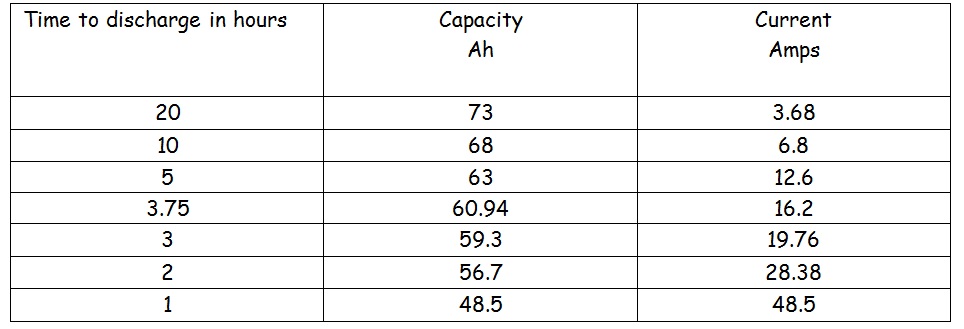
Note the 3.75hr discharge time, at 8MPH a Tramper will travel 30 miles in this time and in absolutely ideal conditions, flat hard surface, hard tyres, 20°C and average weight user the Tramper will draw approximately 16.2 amps. It is unlikely this will be achieved in practice.
So if a Tramper is being driven in demanding conditions and the current is say 40A the range will be smaller than expected because the battery capacity will be reduced.
It must be remembered that these effects are additive so as a worst case example: a Tramper with soft tyres climbing a 1in 5 hill on soft grass and at 0°C:

At 20°C the batteries would give approx. 3 miles range ( 22.8 mins running)
At 0°C the batteries would only give approx. 2.4 miles range.(18.24 mins running)
This was shown 20 years ago when a Tramper climbed Snowdon. The batteries were exhausted after probably 4 miles, the slope was greater, but the hard surface would not have required so much energy to push the machine along.
In the above I have neglected acceleration, on top of the above figures it requires extra energy to accelerate the machine to 8 mph. This means if the user is continually opening and closing the throttle, the range will be further reduced.
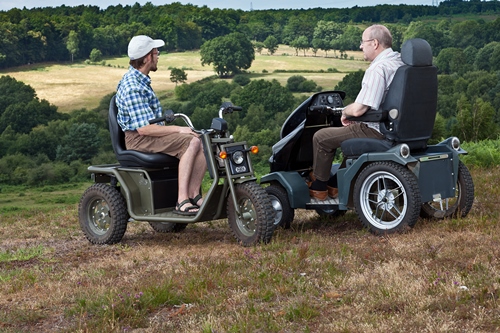
This document is designed to show the factors that determine the range of a Tramper, it must also be remembered that in average footpath or disabled ramblers events Trampers will normally do 15-20 miles on a charge.